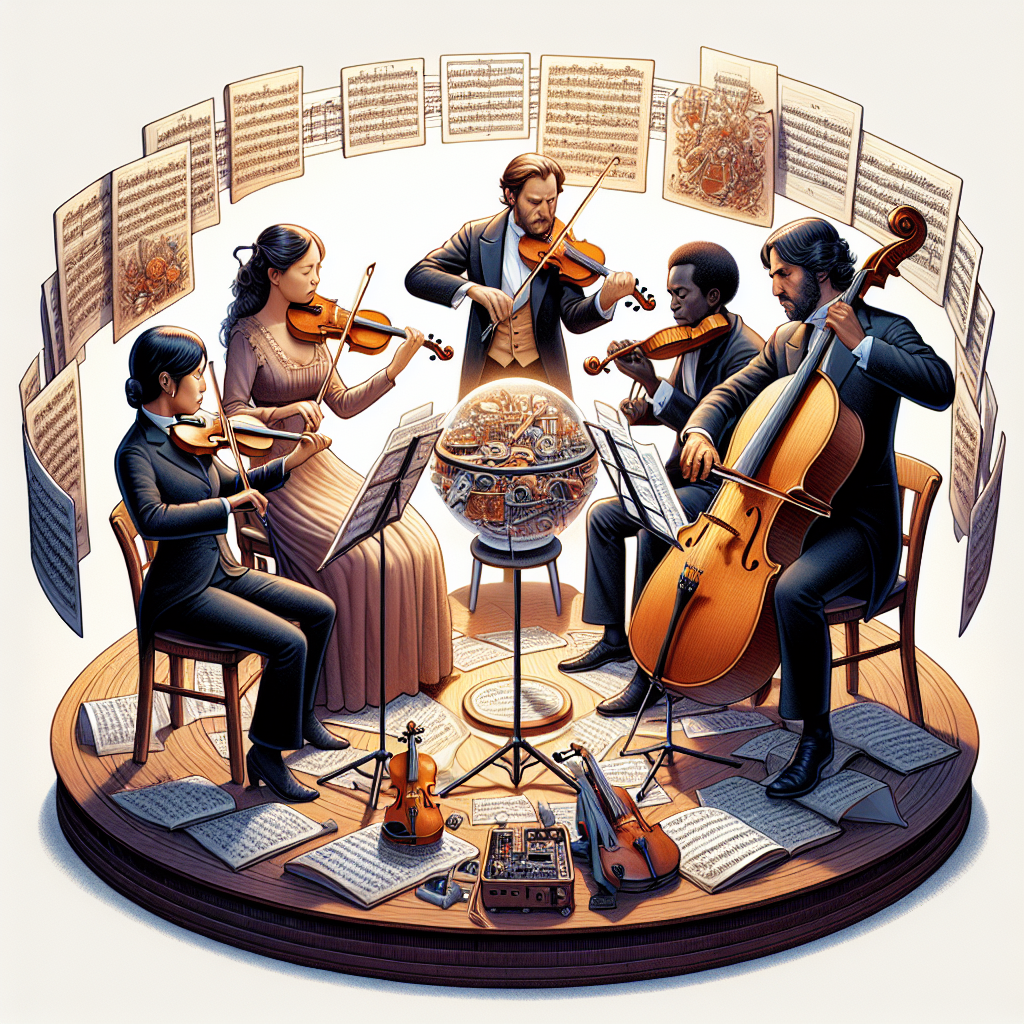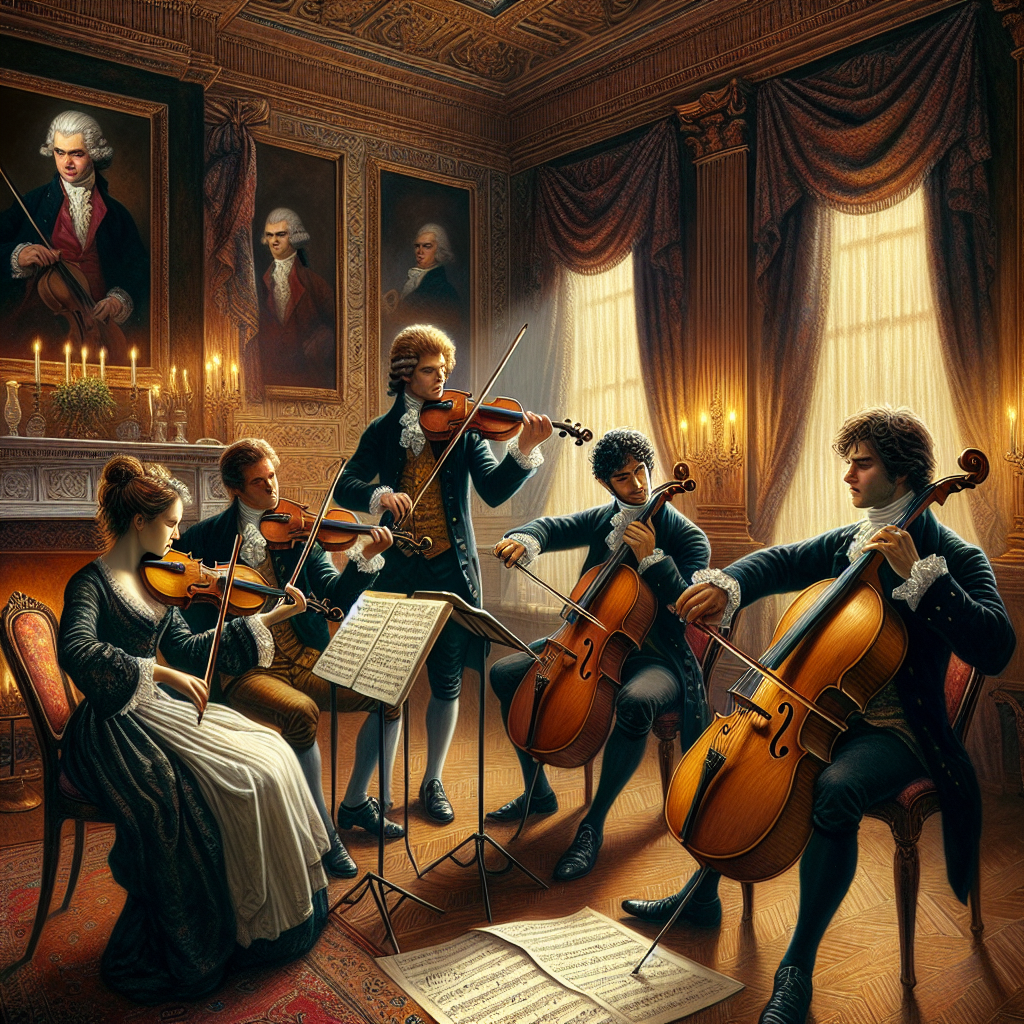
Exploring Beethoven’s ‘Razumovsky’ Quartets: His Chamber Masterpieces
Ludwig van Beethoven, a name synonymous with Western classical music, created an extraordinary legacy that transcends the realm of concert halls and opera houses. His body of work, spanning various genres, has left an indelible mark on the history of music. While his symphonies and piano sonatas are widely celebrated, Beethoven’s chamber music, especially the ‘Razumovsky’ Quartets, holds a special place in the hearts of classical music enthusiasts.
Beethoven’s chamber music, particularly string quartets, provides a compelling insight into his musical genius. The ‘Razumovsky’ Quartets, named after their patron, Count Andreas Razumovsky, are considered some of his finest chamber works. These quartets, composed during the middle period of Beethoven’s career, reflect his evolution as an artist, showcasing his innovative approach to form, harmony, and thematic development.
This article delves into the life and history of Ludwig van Beethoven, with a focus on his works in chamber music, especially the ‘Razumovsky’ Quartets. We will explore the context in which these quartets were composed, their musical characteristics, and their significance in Beethoven’s oeuvre and the broader landscape of classical music.
Beethoven’s Musical Journey
Ludwig van Beethoven was born in December 1770 in Bonn, Germany, into a family of musicians. His father, Johann van Beethoven, recognized Ludwig’s prodigious talent early on and sought to cultivate it, though often with harsh methods. By his adolescence, Beethoven had already made significant progress as both a pianist and a composer, studying under prominent musicians such as Christian Gottlob Neefe.
In 1792, Beethoven moved to Vienna, then the musical capital of Europe, where he would spend the remainder of his life. He studied under Joseph Haydn, Antonio Salieri, and Johann Albrechtsberger, absorbing the Viennese classical style and rapidly establishing himself as a formidable composer and pianist. However, it was not long before Beethoven began to carve out his unique voice, pushing the boundaries of classical forms and harmonic language.
Despite his emerging success, Beethoven’s life was marked by profound personal challenges. By his late 20s, he began to experience hearing loss, a condition that would progressively worsen and ultimately lead to near-total deafness. This devastating ailment, however, did not hinder his creative output. On the contrary, Beethoven’s struggle with his condition seemed to fuel his artistic vision, leading to some of his most daring and emotionally profound works.
The ‘Razumovsky’ Quartets: Context and Patronage
The ‘Razumovsky’ Quartets, Op. 59, were composed in 1805-1806 during Beethoven’s middle period, a time of tremendous creative output and stylistic development. This period is often referred to as Beethoven’s “Heroic” phase, characterized by works that are bold, expansive, and deeply expressive.
The quartets owe their name to Count Andreas Razumovsky, the Russian ambassador to Vienna and an ardent supporter of the arts. Razumovsky commissioned Beethoven to write the quartets, which were intended to combine the sophistication of Viennese classical music with Russian folk themes, reflecting the Count’s heritage and cultural interests.
Beethoven eagerly accepted the commission, seeing it as an opportunity to explore new musical ideas and expand the string quartet genre. The result was a set of three quartets that broke new ground in terms of structure, harmonic experimentation, and thematic complexity. These works represented a significant departure from the earlier quartets of Haydn and Mozart, heralding a new era in chamber music.

Musical Characteristics of the ‘Razumovsky’ Quartets
The ‘Razumovsky’ Quartets are celebrated for their innovation and emotional depth. Each quartet comprises four movements, adhering to the traditional structure, yet Beethoven imbues them with a freshness and vitality that is unmistakable.
In the first quartet, Op. 59 No. 1 in F major, Beethoven introduces a dynamic interplay between the instruments, using intricate counterpoint and bold harmonic shifts. The second movement, a slow and meditative ‘Allegretto vivace e sempre scherzando,’ showcases Beethoven’s ability to create profound emotional contrast within a single piece.
The second quartet, Op. 59 No. 2 in E minor, stands out for its intense drama and passionate expressiveness. The first movement, ‘Allegro,’ is characterized by its brooding character and vigorous rhythmic drive, while the ‘Molto adagio’ that follows offers a moment of sublime introspection. The finale is notable for its vivacity and the incorporation of a Russian theme, paying homage to Razumovsky’s cultural background.
The third quartet, Op. 59 No. 3 in C major, opens with a poignant ‘Introduzione: Andante con moto – Allegro vivace,’ creating an atmosphere of suspense and anticipation. This quartet is often regarded as the most challenging of the three, with its intricate textures and demanding technical passages. The finale, marked ‘Allegro molto,’ is a brilliant and exhilarating conclusion to the set.
Impact and Legacy
Upon their premiere, the ‘Razumovsky’ Quartets received mixed reactions. Some contemporaries were bewildered by their complexity and unconventional character, while others recognized them as works of genius that transcended existing musical norms. Over time, these quartets have come to be viewed as pivotal contributions to the string quartet repertoire, influencing generations of composers and performers.
Beethoven’s ‘Razumovsky’ Quartets expanded the expressive potential of the string quartet, paving the way for future composers to explore new dimensions of instrumental music. The daring harmonic progressions, structural innovations, and emotional depth evident in these works set a new standard for the genre. Composers such as Schubert, Mendelssohn, and Brahms drew inspiration from Beethoven’s quartets, furthering the evolution of chamber music in the 19th century and beyond.
The ‘Razumovsky’ Quartets also solidified Beethoven’s reputation as a trailblazing artist unafraid to challenge convention and explore the furthest reaches of his creative potential. They exemplify his ability to infuse traditional forms with new vitality, transforming them into vehicles for profound artistic expression. This spirit of innovation and exploration is a hallmark of Beethoven’s legacy, resonating throughout his body of work.
Performances and Interpretations
Since their composition, the ‘Razumovsky’ Quartets have been performed by countless ensembles, each bringing their unique interpretation to the music. The quartets’ technical demands and expressive range make them a benchmark for string quartets, challenging musicians to explore the depths of their craft.
Notable recordings of the ‘Razumovsky’ Quartets include those by the Budapest String Quartet, the Alban Berg Quartet, and the Takács Quartet, each offering distinct perspectives on Beethoven’s masterworks. The interpretive choices made by these ensembles—such as tempo variations, articulation, and phrasing—reveal the rich complexity and enduring relevance of the quartets.
Live performances of the ‘Razumovsky’ Quartets continue to captivate audiences worldwide. Concertgoers are often struck by the emotional intensity and technical prowess required to bring these pieces to life, gaining a deeper appreciation for Beethoven’s genius. The quartets’ ability to resonate with listeners of all backgrounds speaks to their universal appeal and timeless artistry.
Conclusion
The ‘Razumovsky’ Quartets stand as a testament to Ludwig van Beethoven’s unparalleled contributions to the world of chamber music. Composed during a period of personal and artistic transformation, these works embody the innovative spirit that defines Beethoven’s legacy.
Through the lens of the ‘Razumovsky’ Quartets, we gain insight into Beethoven’s creative process, his willingness to break free from convention, and his relentless pursuit of artistic excellence. These quartets not only expanded the boundaries of the string quartet genre but also left an indelible mark on the trajectory of Western classical music.
As we continue to explore and appreciate Beethoven’s ‘Razumovsky’ Quartets, we are reminded of the power of music to transcend time, culture, and circumstance. The quartets’ enduring relevance and profound emotional impact attest to Beethoven’s extraordinary ability to communicate the human experience through the universal language of music.
In celebrating these masterpieces, we honor Ludwig van Beethoven’s enduring legacy and his invaluable contributions to the rich tapestry of musical history. As performers and listeners alike continue to engage with the ‘Razumovsky’ Quartets, their extraordinary beauty and significance remain ever-present, inspiring and enriching the lives of all who encounter them.